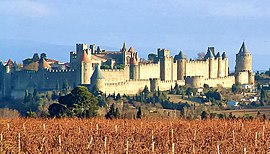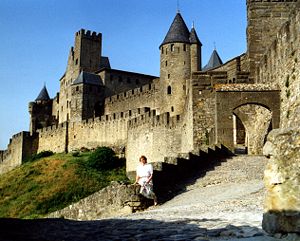Carcassonne
From Wikipedia, the free encyclopedia
| Please expand this article with text translated from the corresponding article in French Wikipedia. (December 2008) After translating, {{Translated|fr|Carcassonne}} must be added to the talk page to ensure copyright compliance.Translation instructions · Translate via Google · Involve your language class |
| This article needs additional citations for verification. Please help improve this article by adding reliable references (ideally, using inline citations). Unsourced material may be challenged and removed. (September 2008) |
| Location | |
| Administration | |
|---|---|
| Country | France |
| Region | Languedoc-Roussillon |
| Department | Aude |
| Arrondissement | Carcassonne |
| Intercommunality | Carcassonne |
| Mayor | Gérard Larrat (2001–2008) |
| Statistics | |
| Elevation | 81–250 m (270–820 ft) (avg. 111 m/360 ft) |
| Land area1 | 65.08 km2 (25.13 sq mi) |
| Population2 (2008) |
45,500 |
| - Density | 699 /km² (1,810 /sq mi) (2008) |
| Miscellaneous | |
| INSEE/Postal code | 11069/ 11000 |
| 1 French Land Register data, which excludes lakes, ponds, glaciers > 1 km² (0.386 sq mi or 247 acres) and river estuaries. | |
| 2 Population sans doubles comptes: residents of multiple communes (e.g., students and military personnel) only counted once. | |
Carcassonne (Occitan: Carcassona) is a fortified French town in the Aude département, of which it is the prefecture, in the former province of Languedoc. It is separated into the fortified Cité de Carcassonne and the more expansive lower city, the ville basse. The folk etymology – involving a châtelaine named Carcas, a ruse ending a siege and the joyous ringing of bells ("Carcas sona"), though memorialized in a neo-Gothic sculpture of Mme. Carcas on a column near the Narbonne Gate – is of modern invention. The fortress, which was thoroughly restored in 1853 by the theorist and architect Eugène Viollet-le-Duc, was added to the UNESCO list of World Heritage Sites in 1997.[1]
Contents |
[edit] History

| Historic Fortified City of Carcassonne* | |
|---|---|
| UNESCO World Heritage Site | |
 |
|
| State Party | |
| Type | Cultural |
| Criteria | ii, iv |
| Reference | 345 |
| Region** | Europe and North America |
| Inscription history | |
| Inscription | 1997 (21st Session) |
| * Name as inscribed on World Heritage List. ** Region as classified by UNESCO. |
|
First signs of settlement in the region have been dated to about 3500 BC, but the hill site of Carsac – a Celtic place-name that has been retained at other sites in the south – became an important trading place in the 6th century BC. The Volcae Tectosages fortified the oppidum.
Carcassonne became strategically identified when Romans fortified the hilltop around 100 BC and eventually made it the colonia of Julia Carsaco, later Carcasum (the process of swapping consonant is a metathesis). The main part of the lower courses of the northern ramparts dates from Gallo-Roman times. In 462 the Romans officially ceded Septimania to the Visigothic king Theodoric II who had held Carcassonne since 453; he built more fortifications at Carcassonne, which was a frontier post on the northern marches: traces of them still stand. Theodoric is thought to have begun the predecessor of the basilica that is now dedicated to Saint Nazaire. In 508 the Visigoths successfully foiled attacks by the Frankish king Clovis. Saracens from Barcelona took Carcassonne in 725, but King Pippin the Younger drove them away in 759-60; though he took most of the south of France, he was unable to penetrate the impregnable fortress of Carcassonne.
A medieval fiefdom, the county of Carcassonne, controlled the city and its environs. It was often united with the County of Razès. The origins of Carcassonne as a county probably lie in local representatives of the Visigoths, but the first count known by name is Bello of the time of Charlemagne. Bello founded a dynasty, the Bellonids, which would rule many honores in Septimania and Catalonia for three centuries.
In 1067 Carcassonne became the property of Raimond Bernard Trencavel, viscount of Albi and Nîmes, through his marriage with Ermengard, sister of the last count of Carcassonne. In the following centuries the Trencavel family allied in succession either with the counts of Barcelona or of Toulouse. They built the Château Comtal and the Basilica of Saint-Nazaire. In 1096 Pope Urban II blessed the foundation stones of the new cathedral, a Catholic bastion against the Cathar heretics.
Carcassonne became famous in its role in the Albigensian Crusades, when the city was a stronghold of occitan cathars. In August 1209 the crusading army of Simon de Montfort forced its citizens to surrender. After capturing Raymond-Roger de Trencavel and imprisoning and allowing him to die, Montfort made himself the new viscount. He added to the fortifications. Carcassonne became a border citadel between France and the kingdom of Aragon (Spain).
In 1240 Trencavel's son tried to reconquer his old domain but in vain. The city submitted to the rule of kingdom of France in 1247, and King Louis IX founded the new part of the town across the river. He and his successor Philip III built the outer ramparts. Contemporary opinion still considered the fortress impregnable. During the Hundred Years' War, Edward the Black Prince failed to take the city in 1355, although his troops destroyed the Lower Town.
In 1659, the Treaty of Pyrenees transferred the border province of Roussillon to France, and Carcassonne's military significance was reduced. Fortifications were abandoned, and the city became mainly an economic center that concentrated on the woollen textile industry, for which a 1723 source quoted by Fernand Braudel found it “the manufacturing center of Languedoc” [2].
[edit] Main sights
[edit] The fortified city
| This section does not cite any references or sources. Please help improve this article by adding citations to reliable sources (ideally, using inline citations). Unsourced material may be challenged and removed. (July 2008) |
Carcassonne was struck from the roster of official fortifications under Napoleon and the Restoration, and the fortified cité of Carcassonne fell into such disrepair that the French government decided that it should be demolished. A decree to that effect that was made official in 1849 caused an uproar. The antiquary and mayor of Carcassonne, Jean-Pierre Cros-Mayrevieille, and the writer Prosper Mérimée, the first inspector of ancient monuments, led a campaign to preserve the fortress as a historical monument. Later in the year the architect Eugène Viollet-le-Duc, already at work restoring the Basilica of Saint-Nazaire, was commissioned to renovate the place.
In 1853, works began with the west and southwest walling, followed by the towers of the porte Narbonnaise and the principal entrance to the cité. The fortifications were consolidated here and there but the chief attention was paid to restoring the roofing of the towers and the ramparts, where Viollet-le-Duc ordered the destruction of structures that had encroached against the walls, some of them of considerable age. Viollet-le-Duc left copious notes and drawings at his death in 1879, when his pupil Paul Boeswillwald, and later the architect Nodet continued the rehabilitation of Carcassonne.
The restoration was strongly criticized during Viollet-le-Duc's lifetime. Fresh from work in the north of France, he made the error of using slates and restoring the roofs as pointed cones, where local practice was traditionally of tile roofing and low slopes, in a snow-free environment. Yet, overall, Viollet-le-Duc's achievement at Carcassonne is agreed to be a work of genius, though not of strictest authenticity.
Fortification consists of a double ring of ramparts and 53 towers.
[edit] Other
Another bridge, Pont Marengo, crosses the Canal du Midi and provides access to the railway station. Lac de la Cavayère has been created as a recreational lake and is about five minutes from the city centre.
[edit] Economy
The newer part (Ville Basse) of the city on the other side of the Aude river (which dates back from the Middle Ages, created after the crusade) manufactures shoes, rubber and textiles. It is also the center of a major AOC wine-growing region. A major part of its income, however, comes from the tourism connected to the fortifications (Cité) and from boat cruising on the Canal du Midi. Carcassonne receives about three million visitors annually. In the late 1990s Carcassonne airport started taking budget flights to and from European airports and in 2006 had regular flight connections with Dublin, Shannon, Stansted, Liverpool, East Midlands and Charleroi.
[edit] Language
Historically, the language spoken in Carcassonne and throughout Languedoc-Rousillon was not French, but actually the quite different Occitan.
[edit] Sport
Carcassonne was the starting point for a stage in the 2004 Tour de France and a stage finish in the 2006 Tour de France.
As in the rest of the south west of France, rugby union is popular in Carcassonne. The city is represented by Union Sportive Carcassonnaise, known locally simply as USC. The club have a proud history, having played in the French Championship Final in 1925, and currently compete in Federale 1, the third tier of French rugby.
Rugby league is also played, by the AS Carcassonne club. They play in the Elite One Championship. Puig Aubert is the most notable rugby league player to come from the Carcassonne club.
[edit] In popular culture
- The history of Carcassonne is re-told in the novel Labyrinth by Kate Mosse.
- A board game and a video game version of it are named after this town.
- Portions of the 1991 film Robin Hood: Prince of Thieves were shot in and around Carcassonne.
[edit] See also
[edit] Notes
- ^ "Historic Fortified City of Carcassonne". UNESCO. Accessed August 11, 2008.
- ^ Fernand Braudel, The Wheels of Commerce 1982, vol. II of Civilization and Capitalism, p 334
[edit] External links
| Wikimedia Commons has media related to: Carcassonne |
| Wikinews has related news: Kangaroos escape in France |
- Official website of the city of Carcassonne (English) / (French) / (Spanish) / (German) / (Dutch)
- Cité de Carcassonne, from the French Ministry of Culture
|
|||||
|
|||||||






